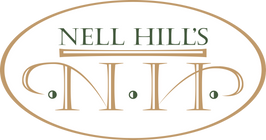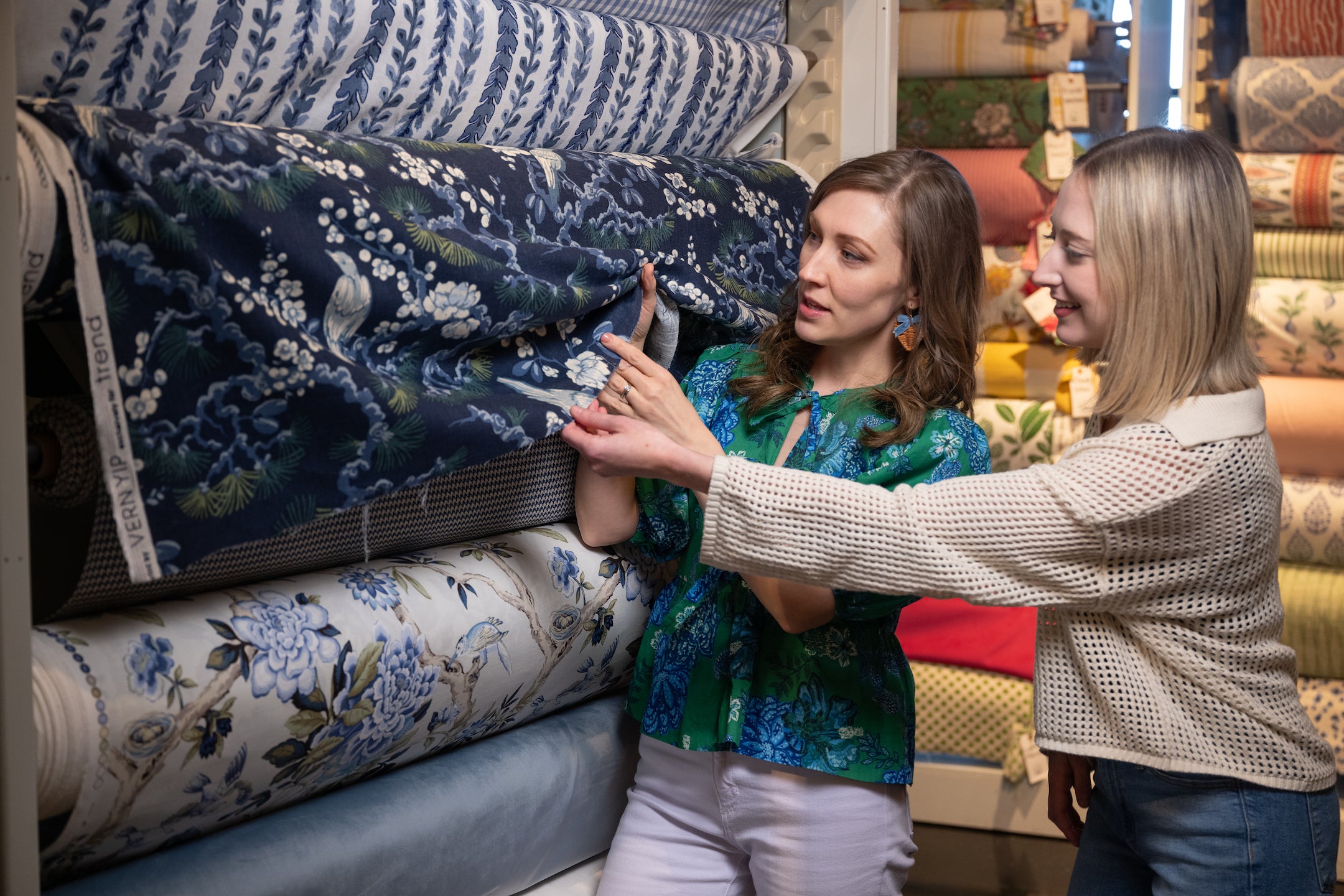An Upholstered Furniture Detailing Glossary - Part 2
Welcome back to part two of our furniture glossary series! In part one, we covered essential furniture terminology to help you better understand and articulate your design preferences. At Nell Hill’s, we’re passionate about helping our customers create spaces that reflect their unique style and personality. Armed with these definitions, you’re well-equipped to navigate the exciting world of furniture design and create spaces that inspire and delight for years to come. In part two, we’ll delve into the intricacies of tufting styles, explore the elegance of designer details like our collective favorite – the contrast welt, and provide a guide to the various types of pillows that can contribute to the transformation of your furniture. Let’s continue this journey together!

Tufting
Tufting is a classic detailing technique that adds depth, texture, and sophistication to furniture pieces. It’s a decorative element that can transform the look of a piece, giving it a sense of luxury and refinement. From utilizing it on headboards, to ottomans to stately wingback chairs, each style brings its own unique character and charm, allowing you to customize your furniture to perfectly match your personal aesthetic. Understanding these tufting techniques will enable you to make informed decisions and add a touch of elegance to your home decor.
Button Tufting
Button tufting is a classic upholstery technique where buttons are sewn deep into the fabric or leather, creating a series of depressions or dimples. This method involves threading through the fabric and padding and securing buttons tightly to the frame, resulting in a tufted pattern. Button tufting not only adds a traditional and elegant look to furniture but also ensures the padding remains securely in place. This technique is commonly seen on sofas, headboards, and ottomans.

Waffle Tufting
Waffle tufting is a type of tufting that creates a grid-like pattern resembling a waffle. This technique involves stitching the fabric in a geometric, square pattern, with each intersection creating a small, square indentation. Waffle tufting provides a modern and textured appearance to upholstered furniture, adding visual interest and depth. It is often used on contemporary pieces like sofas, chairs, and headboards to achieve a stylish and sophisticated look.
Diamond Tufting
Diamond tufting is a sophisticated upholstery technique where the fabric or leather is pulled and secured to create a series of diamond-shaped patterns. This method involves attaching the material to the frame at evenly spaced intervals, forming deep, plush folds that intersect to create a diamond effect. Diamond tufting is known for its luxurious and opulent appearance, commonly found on traditional and high-end furniture such as Chesterfield sofas, tufted headboards, and elegant armchairs.
Biscuit Tufting

Biscuit tufting, also known as square tufting, is an upholstery technique that creates a series of square or rectangular indentations resembling biscuits or cushions. This method involves sewing the fabric at regular intervals, resulting in a grid-like pattern of tufts. Biscuit tufting provides a clean and contemporary look, adding texture and dimension to furniture. It is often used on modern sofas, sectionals, and upholstered beds to achieve a sleek and polished appearance.
Channel Tufting

Channel tufting is a distinctive upholstery technique where the fabric or leather is stitched into parallel channels or grooves, running either vertically or horizontally. This method creates a series of raised ridges and recessed grooves, giving the furniture a streamlined look. Channel tufting is commonly used on mid-century modern and Art Deco-inspired pieces to add a touch of retro sophistication and texture to the design.

Designer Details
The beauty of furniture often lies in the details. Designer details can elevate a piece from ordinary to extraordinary. These finishing touches add character, depth, and a personalized touch to your furniture, ensuring it perfectly complements your home’s decor. In this section, we’ll explore these intricate details, helping you understand how each can be used to enhance your furniture and create a cohesive, stylish look that reflects your unique taste.
Skirting
Skirting refers to the fabric or material that extends from the bottom of upholstered furniture, such as sofas, chairs, or ottomans, to cover the piece’s legs or base. It adds a tailored and finished look, often contributing to a more traditional or classic style. Skirting can vary in length, fullness, and style, including straight, kick pleat, or gathered designs, each bringing a unique aesthetic to the piece. The flooring a skirted pieces will be placed upon should be considered when determining length as carpet typically calls for a shorter skirt while hard surfaces accommodate longer skirts (though the overall difference is minimal).

Ruffles and Pleats
These detailing techniques involve gathering or folding fabric to create decorative textures and patterns. Ruffles are typically loose, gathered fabric strips that add a soft touch to furniture edges or cushions. Pleats, on the other hand, are more structured folds that create crisp, clean lines. Box pleats, knife pleats, and kick pleats are common variations, each lending a different character to the furniture’s appearance.


Scallops
Scallops are made up of a series of convex curves, or adjoined semicircles, often used around the edge of an item like a pillow, skirted furniture piece, or decorative tray. The element is frequently used in fashion as well as home design and decor and are so named because they resemble the edge of the mollusk with the same name (“scallop”).

Welt
Welt, also known as piping or cording, refers to a decorative and functional detail in upholstery where a thin strip of fabric is sewn into the seams of cushions or along the edges of furniture. It serves to provide structure and definition to the furniture piece while also adding a tailored and finished look. Welt can be made from the same fabric as the upholstery for a seamless appearance (“Self Welt”, or it can be a contrasting color or material to create visual interest (“Contrast Welt”).


Flange
A flange is a fabric edge that extends beyond the seams of cushions, pillows, or upholstery. This flat, decorative trim often measures one half to one inch wide and adds a subtle, elegant detail to the overall design. Flanges can be made from the same fabric as the main piece or from a contrasting material for added visual interest.

Contrast Band
A contrast band is a decorative strip of fabric sewn onto furniture to create a distinct border or highlight specific areas, such as the edges of cushion, upholstered piece, or skirt. This band is typically in a different color or pattern than the main upholstery, providing a striking contrast that draws the eye and adds a sophisticated, custom touch to the furniture piece.

Gimp
Gimp refers to a narrow decorative trim made from fabric, often braided or twisted, which is used to conceal upholstery tacks or staples along the edges of furniture. Gimp is often used with nail head trim to add texture, contrast, and visual interest to upholstery pieces.
Nail Heads
Nail Heads refer to small decorative studs or tacks used to secure upholstery fabric to furniture frames. Nail head can also be used on their own or with gimp. Some furniture frames can accommodate the addition of nail heads, while other frames that come standard with nail head may be able to accommodate the removal of nail heads. Nail heads may be spaced at varying widths, from multiple inches apart to nearly touching.

Trim
Trim refers to decorative elements added to furniture or upholstery to enhance its appearance. This can include various types of embellishments such as fringe, tassels, braids, tape or decorative nails. Trim is often used to accentuate the lines and contours of furniture pieces, add texture and dimension, and complement the overall design aesthetic. It can be applied along the edges, seams, or borders of furniture, as well as on cushions, pillows, and other upholstered surfaces. Trim can range from subtle and understated to bold and ornate, depending on the desired style and effect.

Boullion and Fringe
Boullion and fringe are both types of decorative trim that are commonly used in upholstery and home decor. Boullion refers to a looped or twisted cord trim that is typically applied to the edges or seams of furniture pieces, such as sofas, chairs, or pillows, to add texture and detail. Fringe, on the other hand, consists of strands of fabric or thread that are attached to the edges or borders of furnishings, creating a decorative fringe effect. Both boullion and fringe trim can be used to embellish upholstery, curtains, pillows, lampshades, and other home accessories, adding a touch of elegance and sophistication to the decor.

Tape Trim

Tape trim, also known as ribbon trim, is a decorative border or edging made from fabric tape that is applied to furniture, curtains, pillows, or other home decor items. Tape trim comes in a variety of widths, colors, patterns, and textures, allowing for endless design possibilities (read more about the art of pillow trim in our blog post). It can be used to add contrast, detail, and visual interest to a plethora of pieces. Tape trim is often applied using sewing techniques, making it a versatile and easy-to-use decorative accent.
Pillows
I consider pillows to be the unsung heroes of furniture design, providing not only comfort but also a significant impact on the overall aesthetic of a space. Whether you’re looking to add a pop of color, texture, or support, choosing the right pillow to accompany your new piece is key. In this section, we’ll explore the various types of pillows and their uses. Understanding these options will help you enhance your furniture with style and functionality, creating a beautifully curated and inviting environment.

Lumbar Pillow
These are designed to help the chair fit you better! A lumbar pillow is a type of decorative pillow that is designed to provide support to the lower back while sitting or reclining. Typically rectangular in shape, lumbar pillows are longer and narrower than standard throw pillows, with dimensions that are optimized for lumbar support. They are commonly used on sofas, armchairs, and beds to promote proper posture and alleviate discomfort or strain in the lower back. Lumbar pillows come in a variety of sizes, styles, and materials, allowing for customization to suit individual preferences and decor themes.

Bolster Pillow
A bolster pillow is a cylindrical or tubular-shaped pillow that is often used for both decorative and functional purposes. Unlike standard square or rectangular throw pillows, bolster pillows have a long, cylindrical shape and are typically filled with a firm, supportive material. Bolster pillows can be used to add visual interest and dimension to sofas, beds, and other seating areas, as well as to provide additional support and comfort while lounging or sleeping. Use them up against the arm of a sofa or chair for additional support. They are available in a variety of sizes, colors, and patterns, making them versatile accessories for enhancing the decor of any room. A bolster pillow is a nice way to add some curves to what might have otherwise been a boxy piece.

24 x 24 Pillows
These pillows are commonly used as accent pillows on sofas, loveseats, and other seating furniture to add comfort and style to the space. With their generous size, 24 x 24 pillows make a bold statement and can serve as focal points in a room’s decor. They are available in a wide range of fabrics, colors, and patterns, allowing for customization to match the aesthetic of any interior design scheme.

27 x 27 Pillows
These oversized pillows are commonly used as euro shams or euro pillows on beds to provide additional support and visual interest. Euro pillows are often used as a backdrop for decorative pillows and accent pillows. With their large size, 27 x 27 pillows create a luxurious and inviting look for the bed, adding comfort and elegance to the bedroom decor. They are available in a variety of fabrics, textures, and designs to complement any bedding ensemble.

I hope you’ve enjoyed parts one and two of our furniture glossary series. Armed with these definitions, you’re now better equipped to make informed decisions about the custom furniture you’re creating. Whether you’re selecting the perfect tufting for your sofa, adding the finishing touches with contrast welt, or choosing pillows that complete your look, these insights will help you create pieces that truly reflect your unique style and personality. At Nell Hill’s, we’re here to guide you every step of the way, ensuring your design journey is as inspiring and delightful as the spaces you create.



